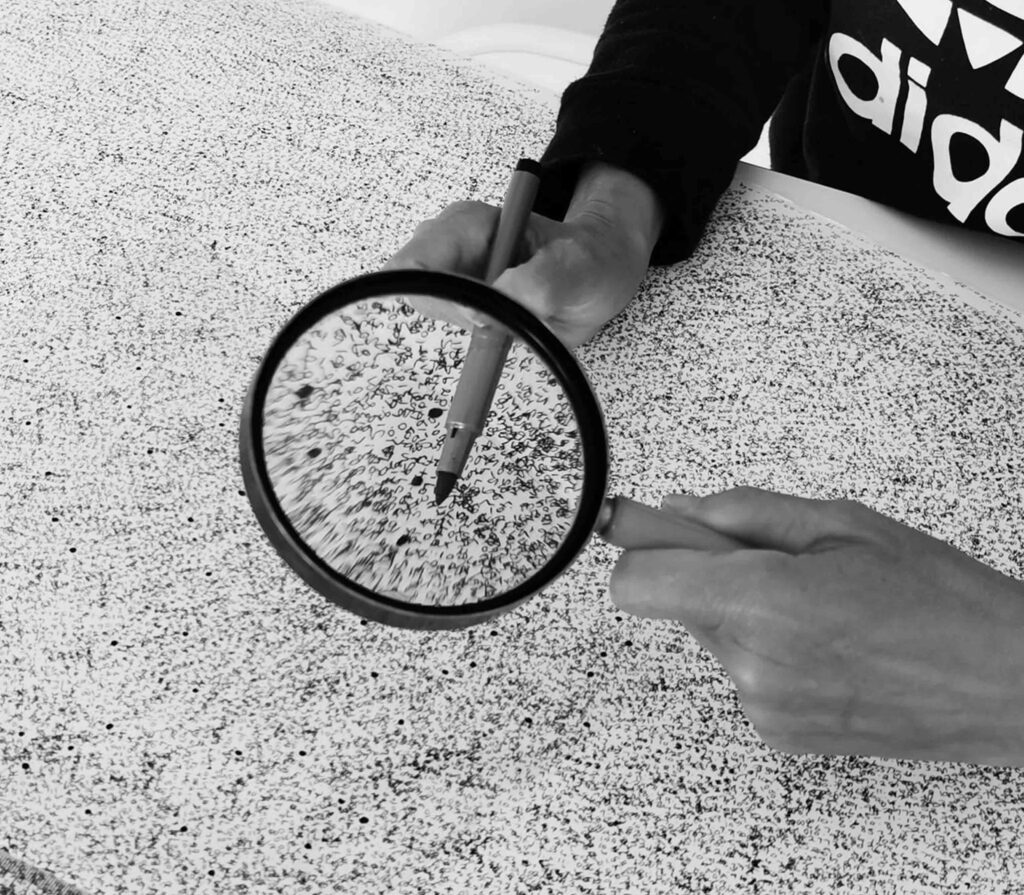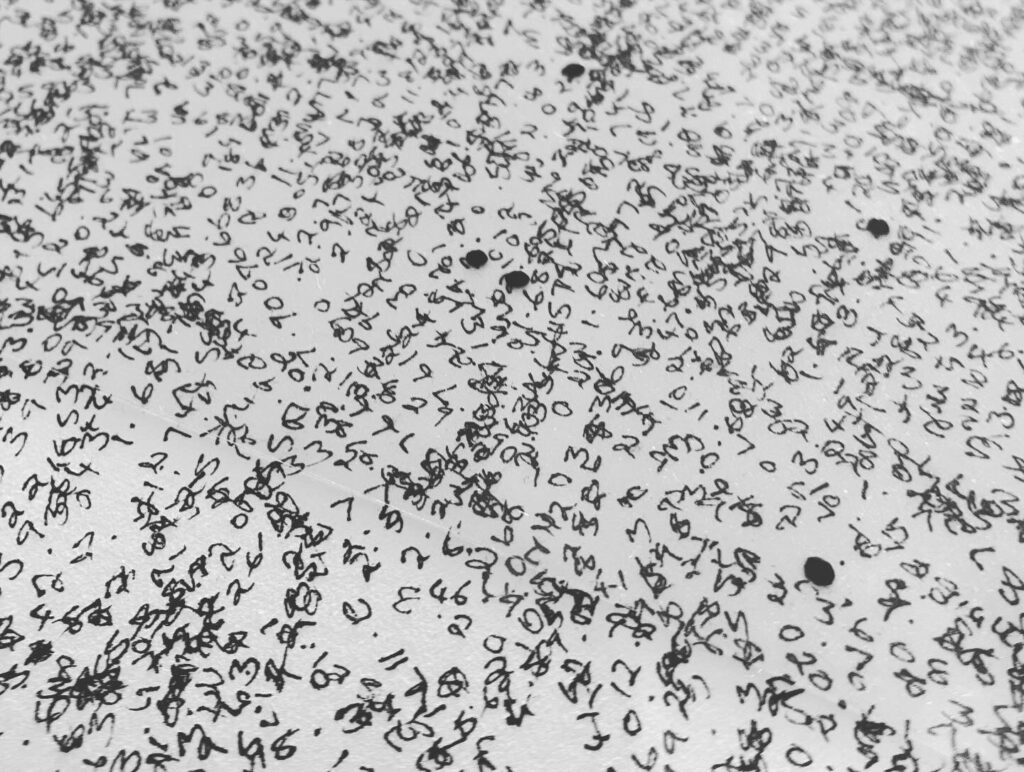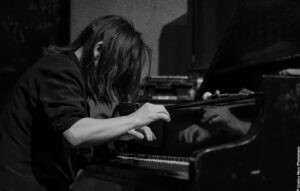Dirty Compositions
Dirty Compositions
Dirty Composition in Three Parts by Sophie Agnel
Dirty Composition in Three Parts began when I placed a sheet of acetate onto Dirty Drawing: October 2022 (temperature) on the 17th October 2022. The drawing at the stage of its development contained 15,232 digits approx. 3,968, and 2,176 numbers approx. I searched the area within the acetate for all of the data points beginning with 9, so for example 9.568721, and marked in permanent pen the digit 9. I then put the acetate sheets over music manuscript paper, it was extremely exciting to realise that the data suddenly, in that simple gesture, had made music.
I commissioned the French pianist Sophie Agnel to compose, play and record a three part music composition titled Dirty Composition in Three Parts in response to the notation drawings titled Dirty Dots.
Sophie began as a classical musician, then moved into modern jazz and now works in free improvisation. She works in “extensive prep-piano” or “extended piano”, a radically materialist way of approaching the whole instrument, Agnel creates a surprising and dynamic personal universe that that plays with lyrical, abstract and sensualist dimensions.
Sophie gave me a few words to accompany the composition
I worked on the small and the large, on islands of dots and on the whole, on certain attractions between the dots, the spaces… and I tried to make music with all that.
Sophie Agnel May 2024
Dirty Composition Sonata no.9; 10th October 2022, by Gareth Parsons
I invited Gareth Parsons an industrial chemist, to respond to one day in the data drawing Dirty Drawing; (October 2022), 2023. His composition Sonata no.9 is derived from soil sensor data obtained on the 10th October 2022, both his father’s and my birthday.
The idea was to manipulate the data so that the changes in temperature or humidity were mapped directly onto a position on the piano keyboard to form a melodic line.
The temperature and humidity were logged every 5 minutes to give a sequence of numbers. At 00:04 the temperature was 3.2°C and rose to 4.4°C at 9:50 and the humidity was 9.4% and changed to 8.8% almost 24 hours later.
Starting with the temperature data, the second value was deducted from the first, the second and third, the third from the fourth and so on to get a change in value. This was multiplied by 100 to give a number greater than 1 which was then converted to an integer. A rule was applied so that if a jump was greater than +14 or -14, it would be divided by 10.
Each note on the keyboard was then assigned a unique number with middle C being 0, C# being +1, D being 2 etc. increasing in semitones up to +48 which is the highest note four octaves above middle C. The same was done descending from middle C with B being -1, B flat being -2 etc down to the lowest A at position -39.
A value was chosen (+11 which is the B above middle C) and the change in pitch added all the way through the dataset giving a series of numbers falling between -39 and +48. The sequence had to be reset at one point so that it all fitted within this range.
The successive values were then assigned the corresponding note and a melodic line was derived from this. The opening melody is derived from the changes in temperature data. The increase in temperature throughout the morning and its subsequent drop and bottoming out in the night can be heard in this melody and it encompass a wide range of the keyboard.
The humidity data was not as variable and could not be used in the same way so successive numbers in a sequence of measurements were used instead to obtain a list of values that could be mapped as above. The humidity data was used to construct the melody at the end of the sonata. This melody uses a narrower range of the keyboard. The rhythm and harmonies used were not taken directly from the data.
There is about 20 minutes of faster music between these two melodies. Material for this was obtained by dividing each melody into 8 segments. Segment 1 of the first melody was then gradually altered by changing the pitches and note values over 13 iterations to become the corresponding segment 1 of the final melody. The same was done for the remaining seven segments. This material was used to write the sonata.
Between the two melodies, the form is cyclic and is split into four sections. Sections 1, 2 and 4 have a first subject, second subject and fugue, each of these constructed from different combinations of the eight segments. As the piece progresses, the segments used move away from the opening melody and become closer to the final melody. Section 3 is a free development section but still uses material at the appropriate point of its metamorphosis between the two melodies. The middle two sections were written last, so the whole sonata was composed from the outside into the centre.
Gareth Parsons
Dirty Composition no.9; 17th October 2022, by Kay Davies
I invited Kay Davies, the harpist who I had worked with subsequently, to visit my studio in the hope that she could make a composition with my first set of notations. It was fascinating watching her turn the dots into notes, and then the notes into music.
Kay developed the manuscript further to create Dirty Composition no.9; 17th October 2022. This composition is utterly unique, because once I had finished drawing all of the data for October the particular arrangement of numbers and dots that I used to create Kays notation are gone, i.e., covered over by more numbers. I find the ephemerality of this process extremely exciting.



“I phrased the composition with a musical bar and time signature to give it form. A key signature, dictated by the starting note was notated in black. To remain intrinsic to the truth of the original notation, i.e. the numbers which became dots transformed to notes, could not be changed. Movement or adjustment to the left or right was implemented to present an aesthetic, playable notation. The grey notes become a creative harmonic addition , as with dynamic instruction, bringing to life a composition of curious melody, explicit in its auditory ownership of the senses. Provocative and melancholy, with haunting tones.“
Kay Davies, November 2023


Research and Development










